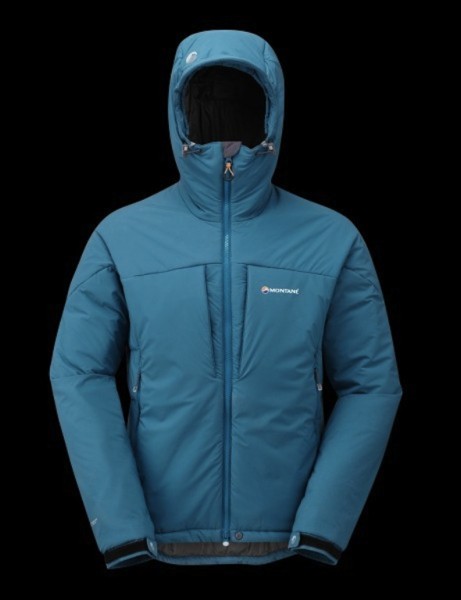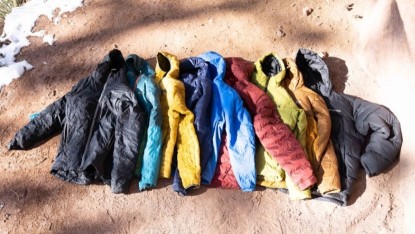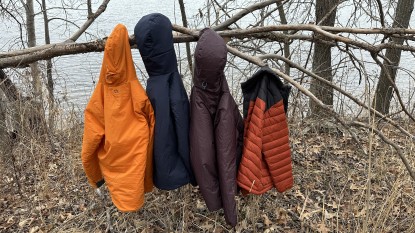Montane Ice Guide Review
Our Verdict
Our Analysis and Test Results
Warmth
The Ice Guide has what Montane calls "duel density zoned" insulation, meaning different insulation weights in different parts of the jacket. 210g PrimaLoft ECO in the front of the jacket, and 170g PrimaLoft ECO throughout the rest of the jacket. This system of insulation keeps the jacket warm in the core, while reducing overall bulk and weight. One important thing to note in terms of materials is that the Ice Guide uses PrimaLoft ECO insulation. This is PrimaLoft's more earth-friendly insulation, made partly from recycled materials. The downside to PrimaLoft ECO however, is that it is less warm for its weight than PrimaLoft ONE. Overall, we found the Ice Guide to be a very warm jacket, and like the Patagonia DAS Parka it is best used as a belay jacket, or for other winter backcountry use.
Weight
In a Medium the Ice Guide is 22.4oz. Considering the warmth, and the plethora of quality features this is relatively light. As mentioned above, the Ice Guide is geared for winter pursuits and it is not intended toe your year-round do-everything jacket.
Features
Features are where the Ice Guide shines. The first important note is the fit. For being such a warm jacket, the fit is a bit tight, and significantly shorter than normal seen on warmer synthetic jackets like the Patagonia DAS Parka. If you want to use the Ice Guide as your winter belay parka you should consider sizing up to accommodate the other layers you may be wearing underneath. On the other hand the slimmer, shorter fit, in combination with the articulated arms, long enough to allow for comfortable climbing, make for a jacket more or less asking to be climbed in. We climbed several pitches of ice in the Ice Guide on cold days and found that it moved well.
There are lots of pockets on the Ice Guide. Two insulated hand warming pockets positioned out of the way of the harness and pack, two cross-over zippered external chest pockets, and an internal zippered stash pocket.
The hood is very well made and comfortable. There are 3 adjustment points (one back, two in the front). The excess cord from the front adjustment points is routed to the inside of the collar, keeping the cord from flapping in your face. There is also a wire-stiffened brim to hood, which keeps precipitation off your face and helps clear you vision a bit when the hood is up. The wrist closures are Velcro, which we find annoying when the snow sticks to the Velcro and prevents it from securing. in general we prefer simple elastic wrist cuffs. The waist has two one-handed adjustment points to seal in warmth.
There are two special features of the Montane Ice Guide that are worth mentioning:- The first is the secondary waist cinch. In addition to the cinch adjusts on the bottom hem of the jacket, there are two other cinch cords hidden, one in each hand pocket, which allow you to cinch the jacket at your "natural" waist several inches higher up. We found this to be a great way to seal in warmth and is something not found on any other synthetic jackets we tested.
- The second feature also helps seal in warmth. On the inside of the collar there is a long slender baffle which rests just on top of your collar bone all the way around when the jacket is zipped up. Essentially, this mitigates heat loss through the top of the jacket and collar area when the hood is down. It is hard to know exactly if these little features have a significant practical advantage, but they do indicate that Montane is thinking hard about perfecting their jacket designs.
Weather Resistance
The Ice Guide has a Pertex Microlight outer fabric with Pertex Microlight Mini Rip-stop reinforcements on the elbow to forearm. Although Pertex Microlight is water resistant, it is less water resistant when compared to the Pertex Endurance fabric used on the Patagonia DAS Parka. Like we mentioned above, the hood design on the Ice Guide is excellent, and much better than on the DAS, which is something to keep in mind in terms of warmth and weather protection.
Best Application
Ice and winter alpine climbing, ski touring.
Value
Somewhat expensive and also harder to find and try on compared to more well know brands (in the U.S. at least). This is a cold weather specific jacket and is not a good value if you're looking for a versatile year-round jacket. As a winter climbing jacket however, we think its a well engineered piece, and a good choice.





